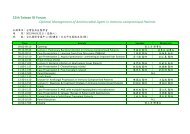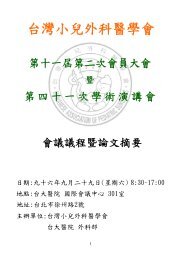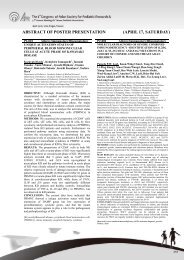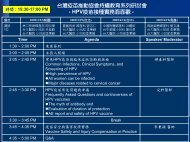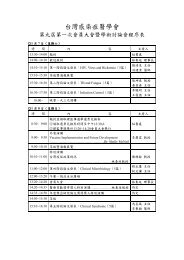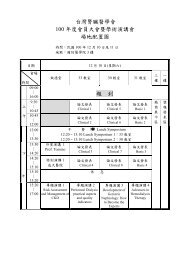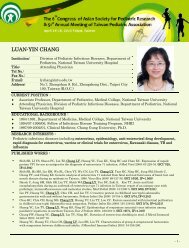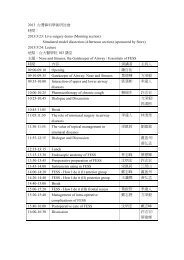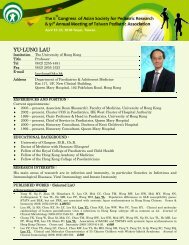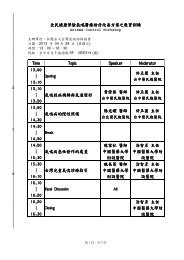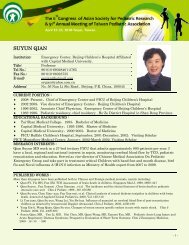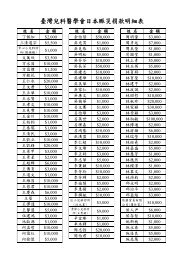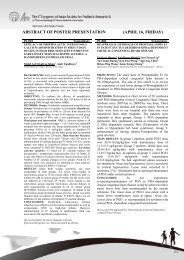ABSTRACT OF INVITED LECTURES AND ORAL PRESENTATION
ABSTRACT OF INVITED LECTURES AND ORAL PRESENTATION
ABSTRACT OF INVITED LECTURES AND ORAL PRESENTATION
- No tags were found...
You also want an ePaper? Increase the reach of your titles
YUMPU automatically turns print PDFs into web optimized ePapers that Google loves.
FP5-03COPY NUMBER VARIATION <strong>AND</strong>TRANSCRIPTOME ANALYSES ONPEDIATRIC BRAIN TUMORS REVEALNOVEL PROGNOSIS FACTORS <strong>AND</strong> RAREINI1 MUTATION IN TAIWANESE ATYPICALTERATOID/RHABDOID TUMOR <strong>AND</strong>MEDULLOBLASTOMASHsei-Wei Wang 1,2,3 , Donald Ming-Tak Ho 4 andTai-Tong Wong 51 Institute of Microbiology and Immunology, 2 Institute of Clinical Medicine,3 Institute of Biochemistry and Molecular Biology, National Yang-MingUniversity; 2 VGH Yang-Ming Genome Research Center, NationalYang-Ming University; 3 Department of Education and Research, Taipei CityHospital; 4 Department of Pathology and Laboratory Medicine, TaipeiVeterans General Hospital; 5 Department of Neurosurgery, NeurologicalInstitute, Veterans General Hospital Taipei, Taipei, TaiwanOBJECTIVE (AIM <strong>OF</strong> THE STUDY): Atypicalteratoid/rhabdoid tumor (AT/RT) is a highly malignant pediatricCNS tumor with the worst prognosis among embryonal tumors(such as medulloblastoma (MB)) or pediatric germ cell tumors(GCTs, such as germinoma (good prognosis) andnon-germinomatous GCT (NGGCT; worse prognosis)). Previousstudies showed deletion or mutation of the INI1 gene and the lackof INI1 protein expression in 100% to 84% of studied AT/RTscases. The underlying mechanisms of different incident andprognosis of various pediatric brain tumors are unclear.METHODS: 10 AT/RT, 24 MB, 7 germinoma and 15 NGMGCTcases were subjected into whole genome copy number variationand transcriptome analysis. The Agilent Human miRNA V2Microarray chip, Affymetrix TM HG-U133 Plus 2.0 whole genomearray, Illumina Human610-Quad Beadchip, and Agilent HumanGenome CGH Microarray Kit 244A chip system were used.Filtrated features were subjected into Systems biology analysisand copy number variation detection for finding unique functionalmodules and aberrant chromosome regions in each pediatric braintumors.MAIN RESULTS: We observed genes responsible for cellproliferation, Ras signaling pathway (NOTCH2 and IQGAP1) andcell survival are abundant in AT/RTs, while genes associated withcell cycle checkpoint and DNA damage repair in MBs. CNSgerminomas also express more DNA damage checkpoint genes(CHEK2 & HUS1), as well as stemness genes (such as OCT4,NANOG and KLF4. Genes associated with neuron differentiationare relative abundant in NGMGCTs. Novel prognosis markerswere identified to divide primary MB patients into high- andmoderate-risk prognostic groups. Array CGH analysis onTaiwanese AT/RT samples revealed no aberration around the INI1gene at 22q11.2. Direct DNA sequencing showed no INI1 genesequence alternation in 7/9 of AT/RTs, and point mutation in onlyone allele of 2 cases, of which only one case have proteinmutation. IHC staining showed INI1 protein is still expressed in55.6% of examined cases. INI1(-) patients possessed worseprognosis.CONCLUSION: This study integrates molecular profiles withclinical observations and provides the underlying pathogenesismechanisms for different pediatric brain tumors. Our data revealnovel pathogenesis mechanisms, prognosis markers and candidatedrug targets. INI1 mutation is rare in Taiwanese patients, making itan erroneous marker for the diagnosis of AT/RT in Taiwanese, andmaybe Asian, cases.FP5-04BEHAVI<strong>ORAL</strong> OUTCOME <strong>OF</strong> ACUTELYMPHOBLASTIC LEUKEMIA SURVIVORS INNATIONAL UNIVERSITY <strong>OF</strong> MALAYSIAMarina M.S., MD 1 , Hamidah A., MD 1 , Zarina A.L., MD 1 ,Rahman Jamal, MD, Vijayalakshmi R. 1 ,Rahman Jamal,MD 1 , Azmi M.Tamil, MD 21 Department of Pediatrics, Faculty of Medicine, National University of Malaysia,Kuala Lumpur, Malaysia; 2 Department of Public Health, Faculty of Medicine,National University of Malaysia, Kuala Lumpur, MalaysiaOBJECTIVES: To determine the behavior outcome ofAcute Lymphoblastic Leukemia (ALL) survivors thatcompleted treatment in University Kebangsaan MalaysiaMedical Centre (UKMMC) from 2000 to 2007.METHODS: This is a case-control study involving ALLsurvivors who were 2 years from completing treatment(chemotherapy only). They received the UK ALL 97/98(Regimen A or B) or Relapsed protocol.57 ALL survivors(age 6 to 18 years old) were compared to a group ofhealthy school children (n = 221). Parents completed theChild Behavior Check List (CBCL) questionnaire toassess behavior functioning.MAIN RESULTS: There were no differences ininternalization, externalization and total scores. However,ALL survivors scored higher in 2 of the sub-scales for“anxious/depressed” and “somatic” (p values were 0.019and 0.022 respectively). The other sub-scales were notsignificant. When the different ethnic groups werecompared, ethnic Malay ALL survivors had significantscores in the sub-scale “anxious” (p = 0.034). Otherfactors analyzed including gender, mean socio-economicstatus, age at diagnosis, age at study entry, types ofchemotherapy, type of ALL classification were notsignificant.CONCLUSION: There is evidence of subtle butsignificant behavioral problems in survivors of childhoodALL. CBCL questionnaire is a valuable tool to be usedby clinicians during follow-up of these children.Long-term follow-up of ALL survivors is warranted, withadded attention to psychosocial morbidities.[Keywords]Acute lymphoblastic leukemia, behavior outcome, ChildBehavior Check List[Keywords]AT/RT, Medulloblastoma, INI1 Germ cell tumor76



